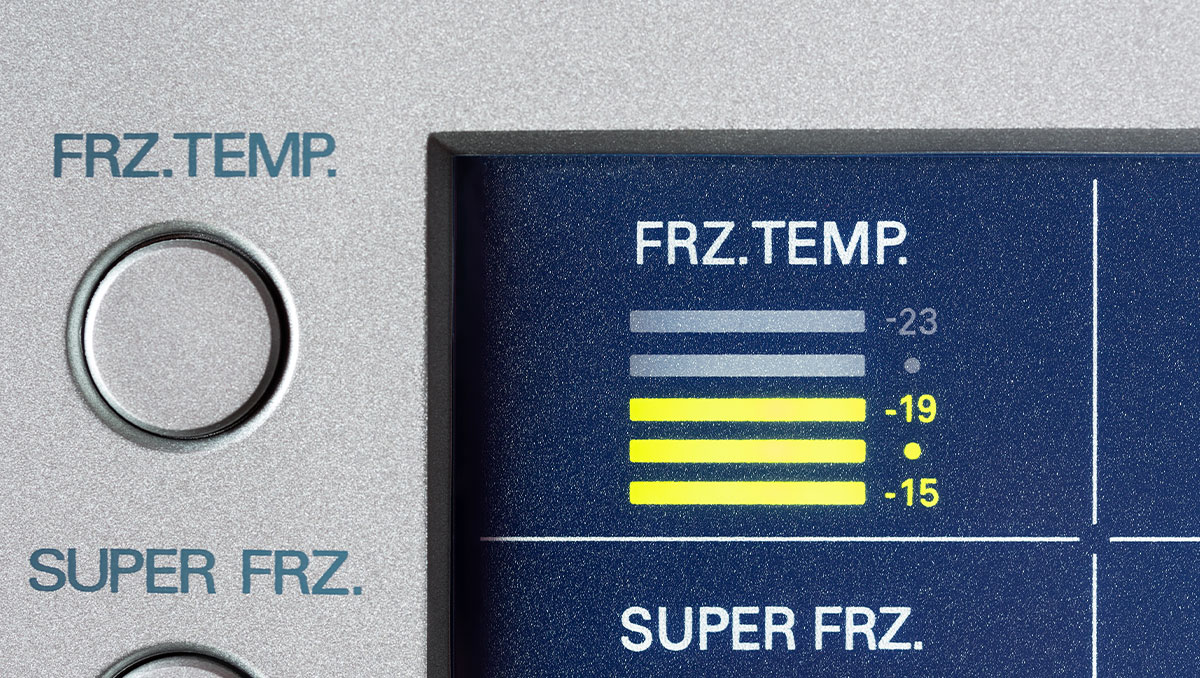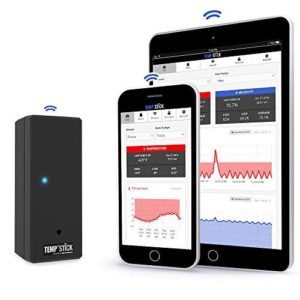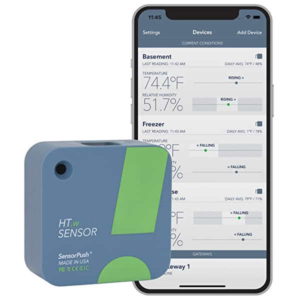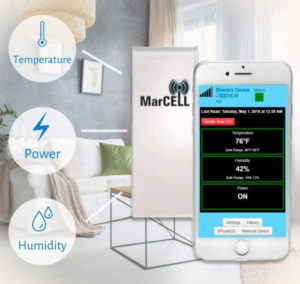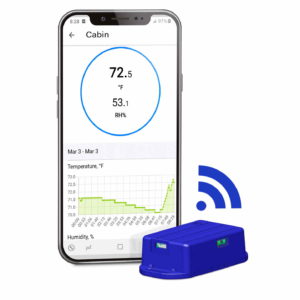If you buy through affiliate links, we may earn commissions, which help support our product reviews.
Last Updated: Feb 8, 2023
The ability to monitor the temperature of your freezer in your home, garage or RV is critical when you are away. Excessive temperatures can lead to spoiled food, product damage, burst pipes, and other costly damage.
Are you looking for a wireless freezer temperature monitoring system to check temperature or humidity in a freezer, a walk-in cooler, a refrigerator, and more, all from your cell phone?
In this article, we discuss freezer alarm monitoring systems that can be watched from a cell phone and introduce the best features of a WiFi freezer alarm sensor.
To Monitor Freezer Temperature with Alarms, do the following:
- Install WiFi in your Home, Office, near the freezer
- (optionally use a Mobile Hotspot or WiFi Extender)
- Get a WiFi Temperature and Humidity Sensor
- Install the App on your Cell Phone to Monitor Freezer
Top Features of WiFi Freezer Alarms:
1. Wireless with Built-In WiFi:
In order to monitor freezer temperatures from your phone, you will need a wireless temperature sensor device so it can connect to your home, office, or mobile hotspot router to transmit the data.
Some wireless freezer sensors may use Bluetooth, but this will only work if your phone is within 100 feet of the sensor, it can’t be monitored when you are far away from home/office.
There are very few products on the market that have Wi-Fi built-in (see list below), some allow for Wi-Fi as an add-on with the purchase of an expensive gateway/hub or require you to install a wall thermostat.
Sharing allows your friends or co-workers to see your freezer temperature monitor that you wish to share with them.
This feature allows them to also watch the freezer temperature alarms, and get alerts if you want them to. They would simply install the App on their mobile phone and create an account. Then you can share 1 or more of your sensors with them.
3. Ping Update Interval:
The update interval or frequency is how often the temperature sensor sends the data to the wireless network so you can view it on your cell phone.
You will want updates every 5 minutes or so. Most sensors should update every few minutes, or allow you to select the update frequency as this could be a trade-off for longer battery life.
4. Freezer Temperature Graphs
With a good mobile phone app, you can see graphs of the temperature and humidity data for each of your freezer sensors.
For example, you can see in the graph below the temperature lows and highs and what time of day this occurs. This can help you locate the problems causing the high or low temperature for the area you are monitoring or pending equipment failures.
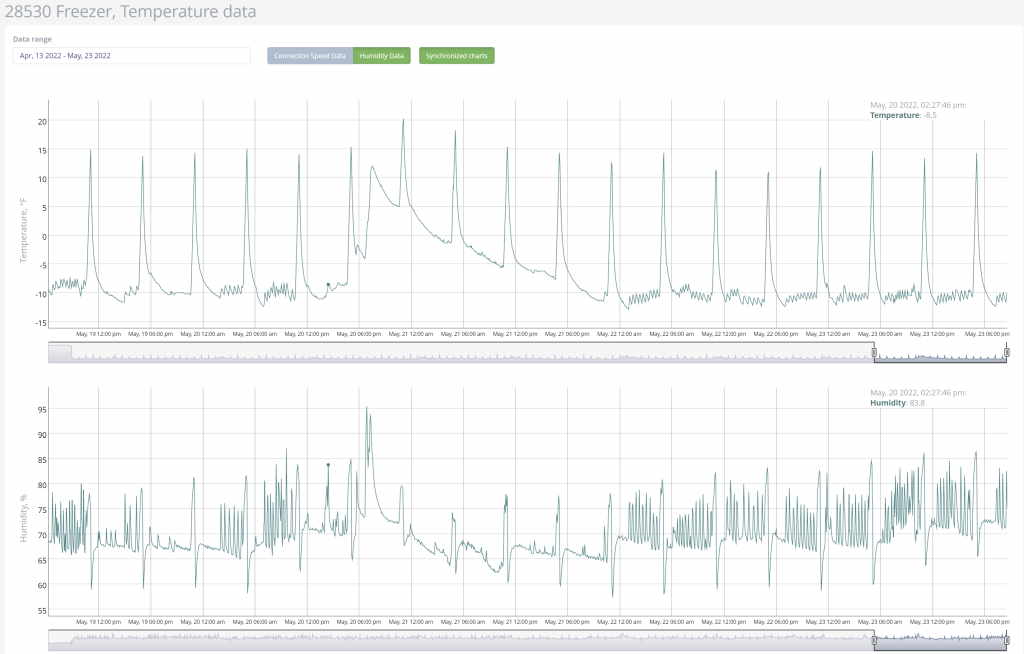
5. Freezer Alarm Monitoring with Data Logging:
The freezer sensor should be able to Record or Log the Temperature and Humidity data in case the Wi-Fi signal is lost or not in range. Once Wi-Fi is restored, it can connect automatically and upload the recorded data to the cloud.
As a bonus, this allows you to record temperatures in a remote location (away from any Wi-Fi), and you could even use your phone’s mobile hotspot to retrieve the data at any time.
Just add your phone’s hotspot as one of the Wi-Fi Profiles when you set up your new freezer temperature sensor.
The temperature sensor should take a measurement or sample every few minutes, this is a reasonable amount of time to record each data point.
(see our related article on additional benefits of a wireless humidity sensor)
6. Freezer Alerts sent to Multiple People:
A commercial freezer alarm allows you the ability to send High/Low Temperature Alerts to more than 1 email address. For example, the temperature sensor email alert can be sent to a friend or employee in case you don’t receive the alert, or you are out of town.
It’s also possible to forward an email alert as an SMS text message to your phone using your mobile email address.
Some vendors support sending voice call alerts, which is great for emergency notifications in the middle of the night.
7. Long Battery Life and Small Size:
For a battery-powered freezer sensor, the typical battery life should be about 6 months with 4-5 minute updates.
Some temperature sensors say the batteries last 1 year or more, but that is because they only update once every hour. That is not frequent enough if something should happen to the wireless router or a power outage in order to be notified in time.
Battery life will vary depending on how close the freezer temperature sensor is to your wireless router and its update interval.
Also, consider the size of the freezer and sensor, a small-sized temperature sensor is great, so it can be placed in many locations without being obstructive.
8. External Power, for Permanent Install:
A wireless freezer sensor that can run off of external power is another great feature, you can install it in a more permanent location and not worry about changing the batteries.
This should be a common micro USB power cable. so it could be plugged into any laptop or cell phone charger or a dedicated AC adapter.
9. Alerts when Power goes Out:
If you plug in the freezer temperature device to external power, and the power is lost, you should get an alert.
This is a powerful feature since you can get power loss alerts for your Home or Office, for example.
However, in order for this to work, your wireless home router must be connected to an Uninterruptible Power Supply (UPS), Battery Backup. I like this one for my home router and have had no issues with it.
All you would need to do is plug your WiFi router(s) into the power backup and plug the freezer temperature monitor into a regular outlet. So when the power goes out or is restored, you get an alert.
A Mobile Hotspot should work fine too since they have internal batteries if power is lost.
10. Use a WiFi Extender (if needed)
Many freezers have thick metal walls or insulation that reduces the WiFi signal considerably.
Using a good WiFi extender near the freezer should boost the signal inside the freezer so the freezer temperature sensor will work.
A strong signal inside the freezer will help the batteries last longer.
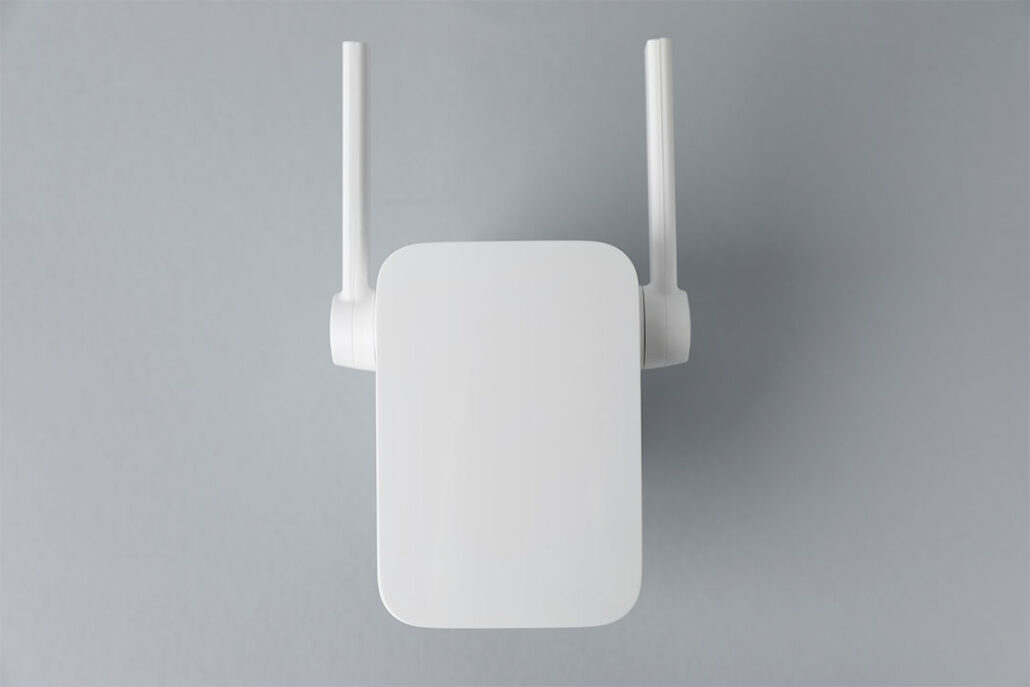
11. Monitor Freezer from your Cell Phone using an App:
A good freezer sensor should include an App that works on both a mobile phone and a Desktop browser. The App should allow you to see Full Graphs of the Temperature, Humidity (if equipped), and Battery Levels.
Monitor many temperature sensors from the same mobile App.
You should be able to set Alerts for High or Low temperature levels. This is probably the main reason you want a remote temperature sensor in the first place.
12. No Special Permissions needed from the Phone App:
When you install the App for your freezer temperature Sensor device, it should not ask for extra Permissions to access Media, Location, or Contacts, only Notifications.
There is no need for this kind of special access to your mobile phone, beware.
13. Alert if the WiFi Freezer Alarm Sensor is Not Updating:
This can be a critical feature since you will want to know if your sensor has stopped working or is unable to send the temperature data to the cloud.
Maybe the internet is down, power is out in the area or there is some other problem with the sensor, so, you will want to know if there is a loss of communication.
You may decide which features above are important to you, but it is worth pointing them out.
Having multiple sensors may be a good idea in your freezer, room, or area you want to monitor, just in case you may not return for a long time and need the added redundancy.
Best WiFi Freezer Alarms & Refrigerator Monitor Reviews:
The following freezer alarm sensors are capable of being used in deep freezers that go no lower than -40 degrees.
Temp Stick – WiFi Temperature & Humidity Sensor (Made in the USA)
Setup Experience:
Following the setup instructions, we were able to connect to our router. After installing the app, a high temperature reading showed up on the app screen, but we saw it needs about 1 hour to calibrate. This just means it creates some internal heat while in the setup process. After a while, the temperature and humidity were showing more accurate readings.
We immediately switched out the alkaline batteries with Energizer lithiums as they are much better in extreme temperatures for electronics. If you are going to use Temp Stick in a freezer, be sure to switch the batteries.
Also, note that this works on 2.4 GHz Wi-Fi only. Almost all routers that support 5 GHz will support 2.4, just make sure yours is enabled. Check with your internet provider if you are not sure about 2.4 GHz WiFi support.
Pros
- No monthly subscription;
- Alerts when loses connection;
- Unlimited data storage;
- 3 Year warranty;
- Text and Email alerts included;
- 1 Year Battery life;
Cons
- No User Sharing;
- Powered from battery only;
Overall Experience:
The Temp Stick works great, but we changed the default reporting from 1 hour to 15 minutes. Once per hour is too long.
We set up alerts for when the temperature was out of range and got the emails as expected. The alert was set for loss of internet connection and that worked also. Take note that if the power goes your router also goes out, this will send the loss of communication alert.
Multiple people can get the same alert, this is good as a backup when one is not enough.
With all of those amazing features, you’ll rest easy knowing that, if something happens to your home or equipment, you’ll have a much better chance of saving it from a possible disaster.
Tested Features:
- Wireless Range tested to ~250 feet.
- Alerts sent to multiple people.
- Not waterproof.
- Historical Data export (CSV format).
- Mobile and desktop apps are full featured.
- Connected to 2 different MiFi hotspots (for wifi link)
Technical Details:
| Dimensions | 2.25 x 2.25 x 0.8 inches |
| Weight | 3.4 ounces |
| Model number | Temp Stick |
| Batteries | 2 AA batteries required. |
SensorPush HT.w Wireless Thermometer/Hygrometer
Setup Experience:
Following the setup instructions, we downloaded the app and then were able to connect the sensor to our phone. It uses Bluetooth only, so we had to be sure Bluetooth was enabled on our test phone.
It seems to check in every minute or so, and the temperature and humidity graphs do appear to work well.
Note that this works on your phone’s Bluetooth only.
Pros
- No monthly subscription;tion;
- Unlimited data storage;
- Very accurate;
- In-App alerts included;
- 2+ Years Battery life;
Cons
- No User Sharing;
- No alert when sensor loses connection
Overall Experience:
The SensorPush works great, and with sensor updates that default to 1 minute.
We set up alerts for when the temperature was out of range and got the notification on the phone. SensorPush will not send email alerts unless you have the optional WiFi Gateway installed.
The SensorPush is really a “local” sensor, and can only be monitored globally if you get the optional WiFi Gateway. You may want to consider the gateway in order to watch the temperature outside the freezer walls.
We did like the accuracy of the sensor, and it’s a tiny device. So, you’ll rest easy knowing that, if something happens to your home or equipment, you’ll have a much better chance of saving it from a possible disaster.
Tested Features:
- Bluetooth Range tested to ~150 feet.
- Alerts to phone app.
- Splashproof.
- Attaches easily to the equipment frame.
- Mobile app is full featured.
- Bluetooth only, extra equipment needed for Internet access
Technical Details:
| Dimensions | 1.57 x 1.57 x 0.6 inches |
| Weight | 2.8 ounces |
| Model number | HT.w |
| Batteries | 1 Lithium-ion battery included. |
MarCELL Cellular Freezer Temperature, Humidity Monitor
Setup Experience:
Following the setup instructions, and entering the ID of the unit, it started working. Then you have to set the temperature and humidity ranges you want it to monitor.
Marcell works by monitoring the range you set. Then if there is a problem, it immediately notifies you. Otherwise, it records the data values every hour, then uploads them every 8 hours. This shows up as Historical data.
Also, note that Marcell works on cellular only, it does not need Wi-Fi.
Marcell does not use or require your current cell phone plan.
Pros
- No WiFi Needed;
- Alerts when loses connection;
- Unlimited data storage;
- 1 Year warranty;
- Text and Email alerts included;
- AC Line Powered;
Cons
- Subscription $99 per year;
Overall Experience:
The Marcell works well. If you are concerned about the data update frequency, keep in mind it uses a cellular radio, these radios use a bit of power and produce heat which could affect the temperature readings. So, it only updates every 8 hours or when you request an update.
By the way, they charge for these Update requests.
We set up alerts for when the temperature was out of range and got the emails as expected. The alert was set for the loss of internet connection and that worked also. When we plugged the power in we also got the power restored alert.
Multiple people can get the same alert (up to 9), this helps in case of emergencies.
This is a great way to monitor your space and not have to worry about having WiFi. You’ll rest easy knowing that, if something happens to your home or equipment, you’ll have a much better chance of saving it from a possible disaster.
Tested Features:
- Cellular Range (AT&T Coverage).
- Alerts sent to multiple people.
- Not waterproof.
- Historical Data Graph.
- Mobile and desktop apps are full featured.
- Backup battery lasted 46 hours.
Technical Details:
| Dimensions | 5.20 x 2.0 x 1.2 inches |
| Weight | 3.4 ounces |
| Model number | MarCell 4G |
| Batteries | 1 Lithium-ion battery rechargeable |
Trakkit THS – WiFi Freezer Alarm and Sensor
Setup Experience:
The setup instructions show 2 ways of connecting to the home router, WPS button and Manual Setup. Trying both ways we were able to connect to our main router.
Opening the back of the sensor shows it comes with Energizer Lithium batteries.
Note that this works on 2.4 GHz Wi-Fi only. Almost all routers that support 5 GHz will support 2.4, just make sure yours is enabled. Check with your internet provider if you are not sure about 2.4 GHz WiFi support.
Pros
- No monthly subscription;
- Alerts when loses connection;
- 1 Year data storage;
- Updates every 4 minutes;
- Email alerts included;
- 1 Year Warranty
Cons
- Text messages require subscription;
Overall Experience:
The Trakkit THS sensor, may last 6 – 9 months on battery but it updates every 4 minutes.
We set up alerts for when the temperature was out of range and got the emails as expected. The alert was set for loss of internet connection and that worked also. Take note that if the power goes out, your home router/network also goes out, this will send the loss of communication alert.
Multiple people can get the same alert, this is good as a backup when one is not enough. It also supports Sharing, so others can monitor from their own app. Offers text and voice call alerts with a subscription.
With all of those amazing features, you’ll rest easy knowing that, if something happens to your home or equipment, you’ll have a much better chance of saving it from a possible disaster.
Tested Features:
- Wireless Range tested to ~250 feet.
- Alerts sent to multiple people.
- Not waterproof.
- Historical Data export (CSV format).
- Mobile and desktop apps are full featured.
- Connected to 2 different MiFi hotspots (for wifi link)
Technical Details:
| Dimensions | 2.25 x 1.25 x 0.75 inches |
| Weight | 2.4 ounces |
| Model number | TK-TH1 |
| Batteries | 2 AAA batteries Or USB Cord. |
WiFi Range Extender – WiFi Signal Booster for Your Freezer Sensor
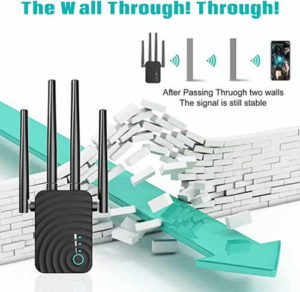 Power Source: AC Plug in
Power Source: AC Plug in Battery Life: NA
Data Link: Wi-Fi (2.4 GHz)
Data Updates: NA
Temperature Range: -40 to 140°F
Temperature Accuracy:
Humidity Range:
Humidity Accuracy:
Dimensions: 3.25 x 2.8 x 0.75 inches
Setup Experience:
The walk-in freezer we tested had a weak WiFi signal inside (tested using a cell phone), so we added this WiFi extender just outside as a Repeater (extender).
The setup instructions show 2 ways of connecting to the home WiFi, WPS button and Manual Setup. Trying both ways we were able to connect to our wifi router.
The extender shows up as a new WiFi on our list as the home network name with the _ext added.
The signal was very strong now. All that was needed was to connect the WiFi freezer sensor to the new _ext network.
Some temperature sensors may have a quick setup. Just push the WPS button on your home wireless router, and then plug in your sensor. Consult the manual for details.
Pros
- Very strong signal;
- Easy setup modes;
- Has ethernet LAN port;
- Extends a 2.4 GHz network;
- 1 Year Warranty
Cons
- Uses a whole wall outlet;
Overall Experience:
This Netfun WiFi extender did a great job of boosting our network as we got almost no signal in the freezer prior to adding the extender.
Once set up, the freezer sensor was reporting the correct temperature.
We were also able to use our cell phone in the freezer. If you have a walk-in freezer, a good test is to use your cell phone, and if needed get the Wifi extender working first before adding the freezer sensor.
Tested Features:
- Wireless Range tested to ~300 feet.
- Connected inside the freezer.
- Easy Setup.
- Extends 2.4 GHz Network.
- Mobile app used for setup.
- Connected to 2 different MiFi hotspots (for link)
Technical Details:
| Dimensions | 3.25 x 2.8 x 0.75 inches |
| Weight | 2.4 ounces |
| Model number | Netfun |
| Batteries | NA |

Walk-in Cooler Temperature Monitoring System
If you have a walk-in cooler or freezer and you would like to remotely monitor the temperature, a wireless freezer temperature sensor would be an excellent way to do that.
You will be able to get alerts if the temperature is too high or low. Perhaps your cooling or heating system failed, and you want to avoid costly damages.
Having a temperature sensor that is recording data is proof to the insurance company that the contents were maintained at a certain temperature.
If the sensor can operate on external power, you would not need to worry about changing the batteries.
Put one or more in the cooler in different areas if needed. You can monitor the temperature during the day to see how well the insulation is working.
Monitor the humidity as well, to watch for moisture levels.
Commercial Freezer Alarms
To monitor the temperature of your commercial refrigerator or freezer, just put a wireless temperature sensor inside and monitor it from your mobile phone.
For example, if you have a walk-in refrigerator or freezer you will be able to monitor its temperature without having to open the refrigerator door.
This is why the wireless link is so beneficial. You can even get alerts if the temperature goes out of range.
If you run a business, you may benefit from the temperature recording feature that will show the insurance company in the event the power goes out.
Monitor Temperature in Buildings, Storage, Server Rooms, Industrial
Use a WiFi freezer sensor to monitor alarms for many locations, such as Server Rooms, Garages, RVs, buildings, storage, and Industrial locations.
Get an alert if they freeze, over-heat, or if the power goes out.
Maybe you have multiple properties you would like to keep an eye on.
This is where a temperature sensor (with built-in WiFi) can really help. Just put a sensor in the area most likely to freeze and you can set an alarm rule that will notify you.
It’s a good idea to consider the tips mentioned above.
With this, you can avoid any costly loss and damage inside your home and business properties.
Multiple Commercial Freezer Temperature Monitoring
Since the temperature sensor connects directly to your wireless router, you can use one to monitor the freezer temperature alarms from any internet-capable device.
You will be able to see if there are cold or warm areas of your freezer and make adjustments to your heating or cooling system.
Also, you will see all your freezer temperature sensors on the same app, add as many as you need. It makes a great addition to your commercial cooling systems.
FAQs:
How do I Monitor the Temperature of my Fridge?
You can monitor fridge temperature with a wireless temperature sensor, you can watch temperature and humidity from your mobile cell phone, even when far away from home.
What is the Best Wireless Freezer Monitoring System?
The best one has built-in WiFi, can send alerts to multiple people, and has a very accurate sensor like the ones listed here, please see the descriptions above for a list of features.
What is a Wireless Temperature Sensor?
A Wireless Temperature Sensor has the ability to measure temperature and transfer that data using WiFi, Bluetooth, or other wireless methods.
What is a Remote Temperature Sensor?
A Remote Temperature Sensor is one that can be placed in a different location than a permanent, built-in temperature sensor.
A good remote temperature sensor will also have wireless communication built-in, such as WiFi or Cellular.
This will allow you to monitor the sensor from a very remote location using your phone.
Also Check out Humidity Sensors
